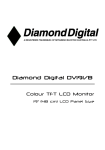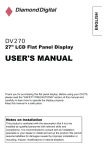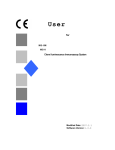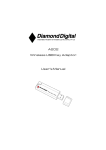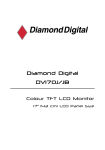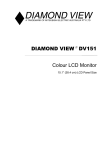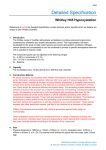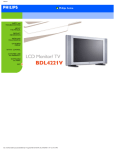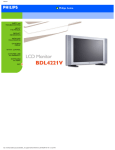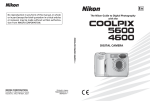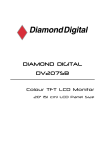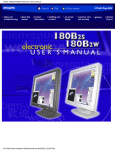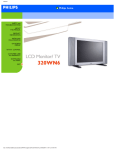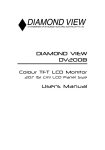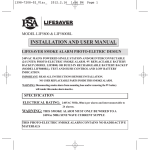Download DV420 User Manual - Mitsubishi Electric Australia
Transcript
DV420 Wide Screen LCD Flat Panel Display 42” (106.7 cm) LCD Panel Size User’s Manual Safety & Troubleshooting Safety and Troubleshooting Information Safety Precautions and Maintenance • FAQs • Troubleshooting • Regulatory Information• Other Related Information Safety precautions and maintenance WARNING: Use of controls, adjustments or procedures other than those specified in this documentation may result in exposure to shock, electrical hazards and/or mechanical hazards. Read and follow these instructions when connecting and using your computer monitor: Operation: ● ● ● ● ● ● ● ● Keep the monitor out of direct sunlight and away from stoves or any other heat source. Remove any object that could fall into ventilation holes or prevent proper cooling of the monitor’s electronics. Do not block the ventilation holes on the cabinet. When positioning the monitor, make sure the power plug and outlet are easily accessible. If turning off the monitor by detaching the power cable or DC power cord, wait for 6 seconds before attaching the power cable or DC power cord for normal operation. Please use approved power cord provided at all times. If your power cord is missing, please contact with your local service center. Do not subject the LCD monitor to severe vibration or high impact conditions during operation. Do not knock or drop the monitor during operation or transportation. Maintenance: ● ● ● To protect your display from possible damage, do not put excessive pressure on the LCD panel. When moving your monitor, grasp the frame to lift; do not lift the monitor by placing your hand or fingers on the LCD panel. Unplug the monitor if you are not going to use it for an extensive period of time. Unplug the monitor if you need to clean it with a slightly damp cloth. The screen may be wiped with a dry cloth when the power is off. However, never use organic solvent, such as alcohol, or ammonia-based liquids to clean your monitor. Safety & Troubleshooting ● ● ● ● ● To avoid the risk of shock or permanent damage to the set, do not expose the monitor to dust, rain, water, or excessive moisture environment. If your monitor gets wet, wipe it with dry cloth as soon as possible. If foreign substances or water gets in the monitor, please turn the power off immediately and disconnect the power cord. Then, remove the foreign substance or water, and send it to the maintenance center. Do not store or use the LCD monitor in locations exposed to heat, direct sunlight or extreme cold. Do not subject the product to severe vibration or high impact conditions. Do not place the product inside a car boot. In order to maintain the best performance of your monitor and maximise the lifetime, please use the monitor in a location that falls within the following temperature and humidity ranges. ❍ Temperature: 0-35°C 32-95°F ❍ Humidity: 20-80% RH Service: ● ● ● ● The casing cover should be opened only by qualified service personnel. If there is any need for any document for repair or integration, please contact your local service centre. For transportation information, please refer to "Physical Specifications". Do not leave your monitor in a car/trunk under direct sunlight. Consult a service technician if the monitor does not operate normally, or you are not sure what procedure to take after following the operating instructions given in this manual. About This Manual About This Manual About This Guide • Notational Descriptions About This Guide This electronic user guide is intended for anyone who uses the DV420 LCD Display. It describes the features, setup, operation and other important information. It includes the following sections: ● ● ● ● ● ● ● ● Safety and Troubleshooting Information provides tips and solutions for common problems as well as other related information you may need. About This Electronic User's Manual gives an overview of information included, along with notation icon descriptions and other documentation for your reference. Product Information gives an overview of the monitor's features as well as the technical specifications for this monitor. Installing Your Monitor describes the initial setup process and gives an overview of how to use the monitor. On-Screen Display provides information on adjusting the settings on your monitor. Remote Control provides information on adjusting the settings for your TV function. Customer Care and Warranty contains a list of Mitsubishi Service Centres as well as help desk phone numbers and information on the warranty applicable to your product. Download and Print Option transfers this entire manual to your hard drive for easy reference. Notational Descriptions The following subsections describe notational conventions used in this document. About This Manual Notes, Cautions and Warnings Throughout this guide blocks of text may be accompanied by an icon and printed in bold or italic type. These blocks contain notes, cautions or warnings. They are used as follows: NOTE: This icon indicates important information and tips that help you make better use of your computer system. CAUTION: This icon indicates information that tells you how to avoid either potential damage to hardware or loss of data. WARNING: This icon indicates the potential for bodily harm and tells you how to avoid the problem. Some warnings may appear in alternate formats and may not be accompanied by an icon. In such cases, the specific presentation of the warning is mandated by the relevant regulatory authority. Product Information Product Information Product Features • Lead-free Product • Technical Specifications • Resolution & Preset Modes • Automatic Power Saving • Physical Specification • Pin Assignment • Product Views Product Features DV420 ● ● ● Advanced management features to maximise productivity ❍ Multiple displays can be daisy chained together to form one image ❍ Monitor is network controllable for remote management ❍ Input connectors: CVBS, S-video, SCART, YPbPr, and optional RF (TV input) Better front of screen experience ❍ Motion adaptive deinterlacing for razor sharp images ❍ 3D comb filter separates colour for a razor-sharp image ❍ WXGA, wide format 1366 x 768 resolution for sharper display ❍ Adaptive brightness intensifier technology ❍ Ready to display SDTV, EDTV, and HDTV formats Extra Features: ❍ Zoom function to enable tiled matrix application ❍ Support height-bandwidth digital content protection decryption ❍ Split screen for dual video/PC display ❍ Picture in picture for public display Lead-free Product Product Information Mitsubishi Electric eliminated toxic substances like lead from its display. Lead-free display helps protect your health and promotes environmentally sound recovery and disposal of waste from electrical and electronic equipment. Mitsubishi Electric complies with the European Community stringent RoHS Directive mandating restrictions on hazardous substances in electrical and electronic equipment. With Mitsubishi Electric, you can be confident that your display device does not harm the environment. Technical Specifications* LCD PANEL • Type TFT LCD • Screen size 42 inch • Pixel Pitch 0.227 x 0.681 mm • LCD Panel type 1366 x 768 pixels R.G.B. vertical stripe Hard coating surface, anti-glare polarizer • Effective viewing area 930.25 x 523.01 mm • Display Colours 8 bit interface (16.7M colours) PC SCANNING • Vertical refresh rate 47Hz-63Hz • Horizontal frequency 45kHz-50kHz PC VIDEO • Video dot rate < 85 MHz • Input impedance - Video 75 ohm - Sync 2.2K ohm • Input signal levels 0.7 Vpp • Sync input signal Separate sync Product Information • Sync polarities Positive and negative • Input Frequency WXGA Hsync 48 kHz, Vsync 60 Hz (N.I.) SVGA Hsync 38 kHz, Vsync 60 Hz (N.I.) VGA/DVI-D Hsync 31 kHz, Vsync 60 Hz (N.I.) • Video interface D-sub, S-Video, TV-RF, SCART composite, component video, and DVI-D AUDIO • Input level for PC/SVHS/SCART 500 mV nominal • Loudspeaker 10W Stereo Audio (10W/channel RMS x2, 200Hz~10kHz, 8 ohm, 10% THD) OPTICAL CHARACTERISTICS • Contrast ratio 1100:1(with DCR on) • Brightness 500 cd/m2 (typ.) • Peak contrast angle 6 o'clock • White Chromaticity x: 0.283 y: 0.297 (at 9300°K) x: 0.313 y: 0.329 (at 6500°K) x: 0.328 y: 0.344 (at 5700°K) • Viewing Angle (C/R >5) Upper >89° (typ.) Lower >89° (typ.) Left >89° (typ.) Right >89° (typ.) • Response time (Grey to Grey) 8ms(typ.) 12ms(max.) sRGB sRGB is a standard for ensuring correct exchange of colours between different devices (e.g. digital cameras, monitors, printers, scanners, etc.) Using a standard unified colour space, sRGB will help represent pictures taken by an sRGB compatible device correctly on your sRGB enabled Mitsubishi monitors. In that way, the colours are calibrated and you can rely on the correctness of the colours shown on your screen. Important with the use of sRGB is that the brightness and contrast of your monitor is fixed to a predefined setting as well as the colour gamut. Therefore it is important to select the sRGB setting in the monitor's OSD. From PC mode, open the OSD by pressing the MENU button of your monitor. Product Information Use the down button to select COLOUR SETTINGS and press MENU again. Then move the down button to select NORMAL COLOUR and press MENU again. * This data is subject to change without notice. Resolution & Preset Modes • Recommended 1360 x 768 at 60Hz 10 factory preset modes: Resolution Mode H. freq (kHz) V. freq (Hz) 640x350 VGA-1 31.469 70.086 640x480 VGA VESA 60 31.469 59.940 640x480 VGA VESA 75 37.500 75.000 720x400 IBM VGA 3H 31.468 70.087 800x600 SVGA VESA 56 35.156 56.250 800x600 SVGA VESA 60 37.879 60.317 800x600 SVGA VESA 75 46.875 75.000 1024x768 XGA VESA 60 48.363 60.004 1024x768 XGA VESA 75 60.023 75.029 1280x768 CVT 47.700 60.000 1280x720 CVT 44.772 59.855 1360x768 VESA 47.700 60.000 480i 15.734 59.940 PC Video 720x480 Product Information 720x576 576i 15.625 50.000 720x480 480p 31.470 60.000 720x576 576p 31.250 50.000 1280x720 720p 37.500 50.000 1280x720 720p 45.000 60.000 1920x1080 1080i 28.125 50.000 1920x1080 1080i 33.750 60.000 Automatic Power Saving If you have a VESA DPMS compliant display card or software installed in your PC, the monitor can automatically reduce its power consumption when not in use. If an input from a keyboard, mouse or other input device is detected, the monitor will 'wake up' automatically. The following table shows the power consumption and signaling of this automatic power saving feature: Power Management Definition VESA Mode Video H-sync V-sync Power Used LED colour Active On Yes Yes 100 W (typ.) Blue Sleep Off No No <5W Amber Switch Off Off - - <3W Off Product Information Physical Specifications • Dimension (WxHxD) * 1272mm x 680mm x 300mm (incl. Pedestal, Speakers) 1052mm x 644mm x 150mm (w/o Pedestal, Speakers) • Weight 35 kg (incl. Pedestal, Speakers) • Power supply 100 — 240 VAC, 60 — 50 Hz • Power consumption PC Mode: 140 W (typ.) TV Mode: 220 W (typ.) • Temperature (operating) 5° C to 35° C • Relative humidity 20% to 80% • System MTBF 50K hrs (excluding CCFL 50Khrs) * This data is subject to change without notice. Pin Assignment 1. The digital only connector (DVI-D) contains 24 signal contacts organized in three rows of eight contacts. Signal pin assignments are listed in the following table: Pin Signal No. Assignment Pin Signal No. Assignment Pin Signal No. Assignment 1 T.M.D.S. Data2- 9 T.M.D.S. Data1- 17 T.M.D.S. Data0- 2 T.M.D.S. Data2+ 10 T.M.D.S. Data1+ 18 T.M.D.S. Data0+ 3 T.M.D.S. Data2/4 Shield 11 T.M.D.S. Data1/3 Shield 19 T.M.D.S. Data0/5 Shield Product Information 4 No connect 12 No connect 20 No connect 5 No connect 13 No connect 21 No connect 6 DDC Clock 14 +5V Power 22 7 DDC Data 15 Hot Plug Detect 23 T.M.D.S. Clock+ 8 No connect 16 Ground (for +5V) 24 T.M.D.S. Clock- 2. The 15-pin D-sub connector (male) of the signal cable: Pin Assignment No. Pin Assignment No. 1 Red video input 9 DDC +5V 2 Green video input 10 Cable detect 3 Blue video input 11 4 Ground 12 Serial data line (SDA) 5 NC 13 H. Sync / H+V 6 Red video ground 14 V. Sync 7 Green video ground 15 Data clock line (SCL) 8 Blue video ground Identical output, connected to pin 10 3. RS232 Connector D-sub 9-pin male connector for communication with a PC. T.M.D.S. Clock Shield Product Information Pin No. RS-232 (EIA-232-A) Function 3 Transmit Data (TD) from DTE to DCE 2 Receive Data (RD) from DCE to DTE 7 Request to Send (RTS) 8 Clear to Send (CTS) 6 DCE Ready (DSR) 5 Signal Ground (SG) 1 Received Line Signal Detector (DCD) 4 DTE Ready (DTR) 9 Ring Indicator 4. SCART Connector Pin No. Signal Pin No. 1 Audio right channel output (0.5 Vrms, < 1K ohms) 2 2 Audio right channel input (0.5 Vrms, > 10K ohms) 1 3 Audio left channel output (0.5 Vrms, < 1K ohms) 6 Product Information 4 Audio ground 4 5 Blue signal ground 5 6 Audio left channel input (0.5 Vrms, > 10K ohms) 3 7 Blue signal I/O (0.7 Vp-p, 75 ohms) 7 8 Function switching I/O (L: < 2V, H: > 10V, 10K ohms) 8 9 Green signal ground 9 10 Intercommunication data line No. 1 10 11 Green signal I/O (0.7 Vp-p, 75 ohms) 11 12 Intercommunication data line No. 2 12 13 Red signal ground 13 14 Blanking signal ground 14 15 Red signal I/O (0.7 Vp-p, 75 ohms) 15 16 Blanking signal I/O (L: < 0.4V, H: >1.0V, 75 ohms) 16 17 Composite video signal ground 18 18 Blanking signal ground 17 19 Composite video signal output (1 Vp-p, 75 ohms, sync: negative) 20 20 Composite video signal input (1 Vp-p, 75 ohms, sync: negative) 19 21 Plug shield (common ground) 21 Installing your LCD Monitor/TV Installing your LCD Monitor/TV Product Description • Connecting to Your PC, TV antenna, DVD/VCR etc. • Getting Started • Optimizing Performance Product Description Installing your LCD Monitor/TV Side View (Left) Installing your LCD Monitor/TV 1 INPUT Increase or decrease the channel number or move up or down to highlight functions in the OSD 2 Increase or decrease the level of audio volume or move left or right to highlight the sub-menu in the selected OSD function 3 4 Select input source MENU 5 Side View (Right) Open the OSD or confirm the selected function DC power switch On/Off Installing your LCD Monitor/TV Rear View 1 Audio input for composite input 2 3 4 5 Composite input S-Video input Earphone output TV tuner Audio (left and right) input for composite signal input. Composite (CVBS) signal input S-Video signal input Earphone output TV tuner input (available in TV version only) Installing your LCD Monitor/TV 1 AC in 2 AC power 3 Speakers output 4 D-Sub output 5 DVI-D input 6 D-Sub input 7 RS232 input 8 RS232 output AC power in AC power switch External speakers output PC analog D-Sub output PC digital input PC analog D-Sub input RS232 network connection Input RS232 network connection output for the use of loop through function Installing your LCD Monitor/TV 9 Audio input for component signal 10 Component input Audio (left and right) input for component signal input Component (YPbPr ) signal input Composite (CVBS) output for the use of loop through function 11 Composite output 12 Audio (left and right) out put for composite signal Audio output for composite output out put. 13 External / EURO-AV 14 Kensington lock SCART connection (for the use of European model only) Kensington lock Optimising Performance ● For best performance, ensure that your display settings are set to 1360x768, 60Hz. Note: You can check the current display settings by pressing the 'MENU' button once. On Screen Display On Screen Display On Screen Display Control • Using Your Remote Control On Screen Display Controls An overall view of the On-Screen Display (OSD) structure is shown below. You can use it as a reference for further adjusting your Monitor/TV. There are two different modes of OSD available for different models: ● ● PC Mode TV Mode Main menu There is a slight difference between PC mode and TV mode: Setup selection is available in TV mode only. Sub-menus Picture: press PC Mode TV Mode to enter sub-menu selections. On Screen Display PC mode Selection How to use In PC mode ● Smart Picture ● Users can press ❍ Normal ❍ Warm ❍ Cool or to toggle between to enter the next sub-menu selection or Press to return to main menu. Adjust image brightness. Brightness ● Press or to adjust, ● Press or ● Press to return to main menu. to open adjacent sub menu selections, Adjust image sharpness. Contrast ● Press or to adjust, ● Press to open adjacent sub-menu selections, ● Press to return to main menu. On Screen Display Automatic fine tuning display geometry and time frequency parameter. Auto Adjust ● Press to start, Store? Yes/No will appear. ● Press ● Press ● or to toggle between Yes and No. to confirm and return to sub-menu. Adjust display geometry and time frequency parameters. ● ● Manual Adjust ● ● Phase: Press sub-menu. or to adjust, Clock: Phase: Press return to sub-menu. or to adjust, Horizontal: Phase: Press and return to sub-menu. Vertical: Phase: Press return to sub-menu. to confirm and return to or or to confirm and to adjust, to adjust, to confirm to confirm and TV mode In TV mode ● Smart Picture ● Users can press ❍ Personal ❍ Movies ❍ Sports ❍ Weak Signal ❍ Multimedia ❍ Night or to toggle between Press to next enter sub-menu selection, or return to main menu. to Adjust image brightness. It is only adjustable when Smart Picture is in personal mode. Brightness ● Press or to adjust, ● Press or ● Press to return to main menu. to open adjacent sub-menu selections, On Screen Display Adjust image sharpness. It is only adjustable when Smart Picture is in personal mode. Contrast ● Press or to adjust, ● Press or ● Press to return to main menu. to open adjacent sub-menu selections, Adjust image color saturation. It is only adjustable when Smart Picture is in personal mode. Colour ● Press or to adjust, ● Press or ● Press to return to main menu. to open adjacent sub-menu selections, Adjust image sharpness. It is adjustable only when Smart Picture is in personal mode. Sharpness ● Press or to adjust, ● Press or ● Press to return to main menu. to open adjacent sub-menu selections, Adjust image hue level. Tint Audio: press PC Mode ● Press or to adjust, ● Press or ● Press to return to main menu. to open adjacent sub-menu selections, to enter sub-menu selections On Screen Display TV Mode Preset audio modes. ● Smart Sound ● ● Users can press ❍ Personal ❍ News ❍ Music ❍ Theatre Press or to toggle between to enter next sub-menu selections or to return to main menu. Adjust audio setting parameters. ● Settings ● ● Users can press ❍ Treble ❍ Bass ❍ Balance Press or or or to toggle between to open adjacent sub-menu selections to return to main menu. On Screen Display Switch virtual surround effect on or off. Virtual Surround Sound ● ● Users can press ❍ On ❍ Off or to toggle between Press or to open adjacent sub-menu selections, return to main menu. Auto Volume Limit, adjust volume level automatically to prevent sudden peak load exceeds design limit. ● AVL ● Features: press Users can press ❍ Yes ❍ No or to toggle between Press or to open adjacent sub-menu selections, to return to main menu. to enter sub-menu selections. PC mode Picture in Picture size choices. ● PIP ● Press to enter PIP sub-menu, and press selection between ❍ Size ❍ Video ❍ Audio ❍ Display Press or or to to return from PIP sub-menu to sub-menu, or press to return to main menu. to On Screen Display PIP Sub-menu PIP window size adjustment. ● Size ● Users can use ❍ Small ❍ Medium ❍ Large ❍ PBP ❍ Off or to toggle between Press or next selection. to return to upper level sub-menu, to enter Video source of the PIP window. ● Video ● Users can use or ❍ TV ❍ AV (CVBS) ❍ S-video ❍ EXT (Scart) to toggle between Press or to open adjacent sub-menu selections, return to upper level sub-menu. to Audio source of the PIP window. ● Audio ● Users can use ❍ PC ❍ PIP or to toggle between Press or to open adjacent sub-menu selections, return to upper level sub-menu. to PIP window location selection. ● Display ● Users can use or to toggle between ❍ Icon1 (upper right corner of the screen) ❍ Icon2 (lower right corner of the screen) ❍ Icon3 (lower left corner of the screen) ❍ Icon4 (upper left corner of the screen) Press or to open adjacent sub-menu selections, return to upper level sub-menu. to On Screen Display Choices of video source for main screen. ● Source ● Users can use or to toggle between ❍ PC ❍ DVI ❍ HDCP ❍ TV ❍ AV (CVBS) ❍ S-video ❍ EXT (Euro connector, Scart) ❍ HD (YPbPr) Press or to open adjacent sub-menu selections, return to upper level sub-menu. to Choices for Zoom function. Zoom ● Users can use sub-menu. to enter next level sub-menu and Zoom Zoom sub-menu ● Zoom Type ● Users can use ❍ Off ❍ 4x4 ❍ 3x3 ❍ 2x2 ❍ 1x5 Press or to confirm and to toggle between to return to upper level sub-menu. This selection is only available when one of zoom types is chosen. When zoom type is off, this selection is unavailable. ● Users can use or to toggle between IDs. For example, when 4x4 is chosen, the ID selection are A1 A2 A3 A3 Zoom ID B1 B2 B3 B4 C1 C2 C3 C4 D1 D2 D3 D4 ● Press to confirm and upper level sub-menu. to return to Zoom Type and exit to On Screen Display TV mode Choices of video source for main screen. ● Users can use or to toggle between each signal source, then press to confirm your select. ❍ PC ❍ DVI ❍ HDCP ❍ TV ❍ AV (CVBS) ❍ S-Video ❍ Ext (Euro connector, Scart) ❍ HD (YPbPr) Source ● Press or to open adjacent sub-menu selections return to upper level sub-menu. Selections of image format. ● Picture Format Users can use ❍ Automatic ❍ 4:3 ❍ Zoom 16:9 ❍ Wide screen or to toggle between to On Screen Display ❍ ● Super wide Press or to open adjacent sub-menu selections return to upper level sub-menu. to Lock specific channels to prevent underage viewers watching unsuitable TV content. ● ● Auto Lock ● Users can use to enter the next level sub-menu. When you select this function for the first time, a sub-menu will appear and ask you to input access code.You can use the number buttons to input a four-digit access code.Then sub-menu will appear and ask you to input the same access code once more to confirm. After the first time, each time you try to access this function, a submenu will appear to request for a access code. If the code is correct, you can start using this function. Note: Please remember that 0711 is a default access code. If you forget the access code you have set, or someone has changed your access code, you can always use 0711 to unlock. Auto Lock sub-menu Lock selected channel from underage viewers. ● Lock Program Press to enter. ● Use to block the current channel, to unlock this channel. Use the number buttons to select the channel you wish to block or unlock. ● Press ● to confirm and return to upper level sub-menu. On Screen Display Change lock program access code. Users need to set a four digit access code to enable the Auto Lock function. Change code ● Use to enter code input mode Use the number buttons to set a new four-digit code ● Press ● to confirm and return to upper level sub menu. Clear all locked channels. ● Press ❍ Clear all ❍ ● Press Use On Off or to toggle between to confirm and clear all locked channel settings. to open adjacent upper level sub-menu selections. Choices for Zoom function. Zoom ● User can use sub-menu. to enter next level sub-menu, and Zoom Zoom sub-menu ● Zoom Type ● Users can use ❍ Off ❍ 4x4 ❍ 3x3 ❍ 2x2 ❍ 1x5 Press or to toggle between to confirm and to return to upper level sub-menu. This selection is only available when one of the zoom types is chosen. When zoom type is off, this selection is unavailable. ● Zoom ID Users can use or to toggle between IDs.For example, when 4x4 is chosen, the ID selections are A1 A2 A3 A3 B1 B2 B3 B4 C1 C2 C3 C4 D1 D2 D3 D4 On Screen Display ● Install: press Press to confirm, then upper level sub-menu. to return to Zoom Type and exit to to enter sub-menu selections. Choices of languages in user interfaces. ● Language or Users can press ❍ ENGLISH ❍ ESPAÑOL ❍ ❍ ❍ to toggle between DEUTSCH ITALIANO ❍ ● Press to open adjacent sub-menu selections to return to the main menu. or Assigning a three digit monitor ID to the unit, so it can be identified when using RS232 to control from remote. Monitor ID ● Use to enter, and to confirm. or to select 1~9 numbers, then Dynamic Contrast Ratio, technology to boost display contrast ratio. DCR ● ● Users can use ❍ On ❍ Off or Press to adjacent sub-menu selections. or to toggle between On Screen Display Turns the light sensor on or off for automatic brightness control. Light Sensor ● ● Users can use ❍ On ❍ Off or Press to open adjacent sub-menu selections. or to toggle between Users need to turn off remote control function when they want to use RS232 protocol to control this unit from afar, so it will remote control commands not to conflict with RS232 commands. Remote Control ● ● Users can use ❍ On ❍ Off or Press to open adjacent sub-menu selections. or to toggle between To reset all settings back to factory defaults. Factory Reset ● ● Users can use ❍ No ❍ Yes Press or to toggle between to confirm. Setup:Setup sub-menu is available in TV modes only. Press menu selections. TV mode (North America model) to enter the sub- On Screen Display Choose of tuner signal inputs. ● Tuner Mode ● Users can press ❍ Antenna ❍ Cable ❍ Auto Then, press or to toggle between to open adjacent sub-menu selections or to return to the main menu. Scan all existing channels from your tuner input. Auto Program ● ● Press to start. Press or to open adjacent sub-menu selections, return to the main menu. to Choose to add or delete channels from available channels. ● ● Channel Edit ● ● ● Press to enter Channel Edit sub-menu. In Channel selection, use you wish to add or delete. or to choose the channel that Then, press to next selection, use or to toggle between ❍ Activate (add) ❍ Skip (delete) Repeat the above two steps to add or delete other channels,or press to confirm and return to upper level sub-menu. Press or to adjacent sub-menu selections. In case of weak signal situations, manually fine-tune channel signals to get the best display quality. Manual Fine Tune ● ● Users can use or to fine tune Press or to adjacent sub-menu selections, return to main menu. to On Screen Display TV broadcasters add rating signals in the broadcasted TV programs. Users can use this function to set up an automatic program rating and blocking mechanism to prevent underage viewers from watching unsuitable movies or TV programs. Rating ● Press ● Press to enter the Rating sub-menu. or to open adjacent sub-menu selections. Rating sub-menu To enable or disable the TV or Movie block function. Block Option ● ● Users can use ❍ On ❍ Off or to toggle between Press or to return to upper level sub- menu , open adjacent sub-menu selections. to There are seven movie ratings. ● Users can use to enter movie rating sub-menu, and use or to choose between G: all ages admitted ❍ PG: Parental guidance suggested ❍ PG13: Parents strongly cautioned ❍ R: Restricted ❍ NC: No children under the age of 17 will be admitted ❍ X: Adults only ❍ (More information will be seen at the end of this section) Moving Rating ● In each rating selection, users can use between ❍ On ❍ Off or to toggle Note: If a lower level rating is blocked, then all the upper level ratings will also be blocked automatically. For example, if PG is blocked, then all the other ratings except G will be blocked. ● Then, press to return to upper level sub- menu, or On Screen Display to adjacent sub-menu selections. There are six TV ratings. ● Users can use or to enter the movie rating sub-menu, and use to choose between: 1) Y: all children ● Users can use ❍ On ❍ Off or to toggle between 2) Y7: Directed to older children ● Users can use or to toggle between ❍ Block ❍ FV: fantasy violence or comic violence 3) G: General audience ● Users can use ❍ On ❍ Off or to toggle between 4) PG: Parental guidance suggested ● TV Rating Users can use or to toggle between ❍ Block ❍ V: violence ❍ S: sexual references ❍ L: strong language ❍ D: suggestive dialogue to block all programs in this rating or part of the programs with specific contents. 5) 14: Parents strongly cautioned. ● Users can use or ❍ Block ❍ V: violence to toggle between On Screen Display S: sexual references L: strong language D: suggestive dialogue ❍ ❍ ❍ to block all programs in this rating or part of the programs with specific contents. 6) MA: Matured audience only. ● Users can use or to toggle between ❍ Block ❍ V: violence ❍ S: sexual references ❍ L: strong language ❍ D: suggestive dialogue to block all programs in this rating or part of the programs with specific contents. (More information will be seen at the end of this section) Note: If a lower level rating is blocked, then all higher level ratings will be also blocked automatically. For example, if Y7 is blocked, then all the other ratings except Y will be blocked. ● Then, press to return to upper level sub- menu, or to open adjacent sub-menu selections. Closed captions are captions that are hidden in the video signal, invisible without a special decoder. It allows hearing impaired TV viewers to read ongoing program dialogues or audio effects. Closed Caption ● Users can press to enter Closed Caption sub-menu. Press or ❍ Caption Mode ❍ CC Display ● Press Closed Caption sub-menu to choose between to return to main menu. On Screen Display There are nine caption modes that can be be selected. ● Caption Mode ● Users can use ❍ CC1 ❍ CC2 ❍ CC3 ❍ CC4 ❍ TXT1 ❍ TXT2 ❍ TXT3 ❍ TXT4 ❍ CC Mute Then press or to toggle between: to confirm and return to upper level sub-menu. Note: The difference between CC and TXT mode is: CC shows a few lines of dialogue only, but TXT (text) uses half or the entire page to display scrolling text information. CC1 ~CC4 are usually showing same contents in different languages. Text mode likewise. Users can use CC display to turn closed caption on/off, which was set previously. CC Display ● ● Users can use ❍ On ❍ Off Then press or to toggle between to confirm and return to upper level sub-menu. About Movie Ratings The movie rating system is set up by Motion Picture Association of America.The main reason is to prevent underage viewers from watching unsuitable movie footage. There are six rating levels, namely G, PG, PG-13, R, NC-17, and X. On Screen Display TV mode (Europe, Asia Pacific models) Scan all existing channels from your tuner input. Auto Program ● ● Press to start. Press or to open adjacent sub-menu selections, to return to the main menu. Select a frequency to use with a specific channel. Manual Store ● ● Use to enter the Manual Store sub-menu, and to switch between selections. Then press or to confirm. Choose channel setting to edit channel, swap channel, edit name, and sort channel. Channel Setting ● ● Use to enter Channel Setting sub-menu, and select between selections. Then press or to to confirm. Select different programs in TV mode. System ● ● Use to enter System sub-menu, and between selections. Then press Manual Store sub-menu to confirm. or to switch On Screen Display ● System ● Users can press or to toggle between ❍ France: scans pan Europe and French TV systems ❍ Western Europe: scans pan Europe TV systems only. Press or to open adjacent sub-menu selections confirm and return to upper level sub-menu. , to Select a frequency to use with a specific channel. Manual Store ● ● Use to enter, and use Then, press to confirm. or or to adjust frequency. to open adjacent sub-menu selections Assign a channel number to the frequency chosen in the above function. Program Number ● ● Ue to enter, and use Press confirm. or or to select a number. to adjacent sub-menu selections, Fine tune the channel frequency to get a better display quality. Fine Tune ● Use to enter, and use ● Then, press selections, to adjust frequency. to adjacent sub-menu to confirm. ● Use to enter storing process. A selection of Store? Yes/No will appear. ● Press ● Store or or ❍ ❍ ● Press Yes No or to toggle between to confirm and return to sub-menu. to On Screen Display Choices to add or delete channels from available channels. ● ● Channel Edit Press enter Channel Edit sub-menu In Channel selection, use you wish to add or delete. or to choose the channel that ● Then, press to next selection, use or to toggle between ❍ Activate (add) ❍ Skip (delete) Repeat the above two steps to add or delete other channels, or, ● Press to confirm and return to upper level sub-menu ● Press or ● to adjacent sub-menu selections. To swap channel numbers between two channels.So users can put preferred channels at front. Channel Swap ● Users can use or ● ● to enter Manual Store sub-menu, to select between selections. Then, to confirm. Channel Swap sub-menu Choose a channel number to be swapped from. From ● or Press to select a channel. to confirm and return to upper level sub-menu. ● Choose a target channel number to be swapped to. To ● ● Use or to select channel. to confirm and return to upper level sub-menu. Execute channel swap. Exchange ● Users can press to execute the swapping move. On Screen Display Modify the channel name from a broadcaster to a user preferred one. Name Edit ● Users can use ● Use ● Press ● ● or to select channel. to name input line. Use or alphabet. Press to open function to select from A to Z, or to open adjacent to confirm and return to upper level sub-menu. Sort channel name sequence in alphabetical order, from A to Z. Those channels without a name will be placed at the end of the sequence according to their frequencies, from small to large. Channel Sort ● Users can use ● Press to enter. to start sorting. Remote Control 1 2 3 AV source: ● To select TV/video source in TV and also PIP window. ● If TV is in Standby mode, press this button to switch the unit ON. Mode: Screen aspect ratio, switch between 4:3, 16:9, wide screen, and super wide. Numerical keys: ● For direct access to programs. ● If TV is in Standby mode, pressing any number will turn the TV on. 4 Previous program: Jump to the previous TV channel. 5 Menu: Turn the On-screen-display (OSD) menu on or off. ● 6 ● ● 7 ● Move the cursor up in OSD Channel up Move the cursor left in OSD Adjust volume down 8 Switching between PC and TV mode. 9 Closed Caption: Function available in North America and Asia Pacific models only. ● 10 ● Move the cursor down in OSD Channel down Remote Control ● 11 ● Move the cursor right in OSD Adjust volume up 12 Confirm the chosen OSD function 13 Freeze: Freeze the screen in video mode or PIP. 14 Status: Display channel number, video/PC mode, and sound mode information. 15 Sound select: ● Switch between mono and stereo, or to choose between Dual I and Dual II for bilingual transmissions. ● For TV sets fitted with NICAM, depending on transmission, you can switch between NICAM stereo and Mono, or between NICAM Dual I, NICAM Dual II, and Mono. 16 PIP Size: Adjusts Picture-in-Picture (PIP) window size between small, medium, large, picture-by-picture (PBP or split screen), and off. 17 PIP position: Change PIP window location on the screen between upper right, lower right, lower left, and upper left. 18 Mute: Disables audio: To enable audio, press the button again. 19 Sleep Timer: Selects a period of time before the unit will switch off automatically. 20 Standby: Sets the TV to standby mode temporary. 27 Smart Sound: Select an audio effect from Music, Theatre, News, and Personal. 28 Smart Picture: Select a picture setting from Sports, Movie, Weak signal, Night, Multimedia, and Personal. The following buttons are using in Teletext mode only, which are available in Europe and some of the Asia Pacific TV systems. 21 Teletext Enlarge: Enlarge teletext context to two times larger. Remote Control Teletext Mix: Adjust opacity of Teletext background. 22 Teletext On/Off: Teletext ON or OFF. 23 24 Teletext Hold: Freezes the teletext page. 25 Main Index: Press the button to return to the main index. 26 Teletext Reveal/Conceal: To view the concealed text information (e.g. question/answer, quiz, etc.) sent by the teletext provider. Press the button to toggle between conceal and reveal mode. These four color buttons allow you to access an item or the page indicated by corresponding color in teletext. Warning: If you are going to control the monitor TV via RS232 interface, to avoid conflicts, you should disable the remote control first. Enter the OSD menu to select Install, or use the remote control to select it. Once the remote control is disabled, you can use the buttons on the unit to enter OSD and enable it, or enable remote control via RS232 command. Customer Care and Warranty Customer Care & Warranty Service Contacts If problems remain after checking this manual, please contact your place of purchase or contact: Australian Service Contacts To locate your nearest Mitsubishi Electric Authorised Service Centre, visit the Customer Support section of our web site at www.MitsubishiElectric.com.au , or contact the Service Department for your state: New South Wales and Australian Capital Territory 348 Victoria Road Rydalmere, NSW, 2116 Telephone: 1300 651 808 Fax: (02) 9684-7684 Queensland 12 / 469 Nudgee Road Hendra, QLD, 4011 (Airlink Business Park) Telephone: (07) 3623-2000 Fax: (07) 3630-1888 South Australia and Northern Territory 77 Port Road Hindmarsh, SA, 5007 Telephone: (08) 8340-0444 Fax: (08) 8340-0555 Victoria and Tasmania 4 / 303 Burwood Hwy East Burwood, VIC, 3151 Telephone: (03) 9262-9899 Fax: (03) 9262-9850 Western Australia 5 / 329 Collier Road Bassendean, WA, 6054 Telephone: (08) 9377-3411 Fax: (08) 9377-3499 FAQs (Frequently Asked Questions) FAQs (Frequently Asked Questions) Safety and Troubleshooting • General FAQs • Screen Adjustments • Compatibility with Other Peripherals • LCD Panel Technology • Ergonomics, Ecology and Safety Standards • Troubleshooting • Regulatory Information • Other Related Information General FAQs Q: When I install my monitor what should I do if the screen shows 'Cannot display this video mode'? A: Set the video source to output at 1360x768 @60Hz. 1. Unplug all cables, then connect your PC to the monitor that you used 2. 3. 4. 5. 6. previously. In the Windows Start Menu, select Settings/Control Panel. In the Control Panel Window, select the Display icon. Inside the Display Control Panel, select the 'Settings' tab. Under the setting tab, in box labeled 'desktop area', move the slidebar to 1360x768 pixels (42"). Open 'Advanced Properties' and set the Refresh Rate to 60Hz, then click OK. Restart your computer and repeat step 2 and 3 to verify that your PC is set at 1360x768@60Hz (42"). Shut down your computer, disconnect your old monitor and reconnect your Mitsubishi Electric LCD display. Turn on your monitor, then turn on your PC. Q: What should I do when screen shows: "This is 85Hz Overscan, Change Computer Display Input To 1360 x 768 @ 60Hz" ? A: It means the signal output from your videocard is 85Hz -- outside the range that the monitor can display. New Generation LCD monitors can temporarily override the overscan, providing you with 10 minutes to change the refresh rate to the recommended settings. FAQs (Frequently Asked Questions) Here's how: Go to your Windows Start menu. Select Settings, then Control Panel. Select Display. Move to Settings and click on the Advanced button. Under Adaptor, change the refresh rate to 56~75Hz. You have 10 minutes to complete the operation; if you do not complete within 10 minutes, power off the monitor then power on and make the appropriate changes. Q: What does 'refresh rate' mean in connection with an LCD monitor? A: The refresh rate is of much less relevance for LCD monitors. LCD monitors display a stable, flicker-free image at 60Hz. There is no visible difference between 85Hz and 60Hz. Setting a high refresh rate may result in image corruption due to the LCD circuitry expecting a lower refresh rate than is provided by the video source. Q: How do I adjust the resolution? A: Your video card/graphic driver and monitor together determine the available resolutions. You can select the desired resolution under Windows® Control Panel with the "Display properties". Q: What if I get lost when I am making monitor adjustments? A: Simply press the OK button, then select 'Reset' to recall all of the original factory settings. FAQs (Frequently Asked Questions) Q: What is the Auto function? A: The AUTO adjustment key restores the optimal screen position, phase and clock settings at the press of a single button – without the need to navigate through OSD menus and control keys. Note: Auto function is available in selected models only. Q: My Monitor has no power (Power LED does not light up). What should I do? A: Make sure the AC power cord is connected to the Monitor. Q: Will the LCD monitor accept an interlaced signal under PC models? A: No. If an Interlace signal is used, the screen displays both odd and even horizontal scanning lines at the same time, thus distorting the picture. Q: What does the Refresh Rate mean for LCD? A: Unlike CRT display technology, where the rate at which the picture is redrawn determines the amount of flicker, an active matrix display uses an active element (TFT) to control each individual pixel and therefore the refresh rate is not applicable to LCD technology. Q: Will the LCD screen be resistant to scratches? A: A protective coating is applied to the surface of the LCD, which is durable to a certain extent (approximately up to the hardness of a 2H pencil). In general, it is recommended that the panel surface is not subject to any excessive shocks or scratches. An optional protective cover with greater scratch resistance is also available. FAQs (Frequently Asked Questions) Q: How should I clean the LCD surface? A: For normal cleaning, use a clean, soft cloth. For extensive cleaning, please use isopropyl alcohol. Do not use other solvents such as ethyl alcohol, ethanol, acetone, hexane, etc. Q: Can the DV420 LCD Display be mounted on the wall ? A: Yes. The DV420 can be wall mounted, using an optional VESA mount. The standard VESA mount holes on the back cover allows the user to mount the display on any VESA standard arm or accessory. Screen Adjustments Q: When I install my monitor, how do I get the best performance from the monitor? A: For best performance, ensure your display settings are set to 1360x768@60Hz. Note: You can check the current display settings by pressing the OSD OK button once. The current display mode is shown in product information in OSD main controls. FAQs (Frequently Asked Questions) Q: How do LCDs compare to CRTs in terms of radiation? A: Because LCDs do not use an electron gun, they do not generate the same amount of radiation at the screen surface. Compatibility with other Peripherals Q: Can I connect my LCD Display to any PC, workstation or Mac? A: Yes. All Mitsubishi Electric LCD monitors are fully compatible with standard PCs, Macs and workstations. You may need a cable adapter to connect the monitor to your Mac system. Please contact your dealer/retailer for more information. Q: Are Mitsubishi Electric LCD Displays Plug-and-Play? A: Yes, the LCD Display is Plug-and-Play compatible with Windows® 9x, 2000 and XP. Q: What is USB (Universal Serial Bus)? A: Think of USB as a smart plug for PC peripherals. USB automatically determines resources (like driver software and bus bandwidth) required by peripherals. USB makes necessary resources available without user intervention. USB eliminates the fear of removing the computer case to install circuit board cards for add-on peripherals. More and more peripherals for multimedia computers come on the market every day. With USB, up to 127 devices can run simultaneously on one computer. USB permits "hot plug-in." No need to shut down, before installing a device. FAQs (Frequently Asked Questions) Q: What is a USB hub ? A: A USB hub provides additional connections to the Universal Serial Bus. A hub's upstream port connects a hub to the host, usually a PC. Multiple downstream ports in a hub allows connection to another hub or device, such as a USB keyboard, camera or printer. LCD Panel Technology Q: What is a Liquid Crystal Display? A: A Liquid Crystal Display (LCD) is an optical device that is commonly used to display ASCII characters and images on digital items such as watches, calculators, portable game consoles, etc. LCD is the technology used for displays in notebooks and other small computers. Like light-emitting diode and gas-plasma technologies, LCD allows displays to be much thinner than cathode ray tube (CRT) technology. LCD consumes much less power than LED and gas-displays because it works on the principle of blocking light rather than emitting it. Q: How are LCDs made? A: LCDs are created from two glass plates separated from each other at a distance of a few microns. The plates are filled with liquid crystal and then sealed together. The top plate is colored with an RGB pattern to make the color filter. Polarizers are then glued to both plates. This combination is sometimes called 'glass' or 'cell.' The LCD cell is assembled into a 'module' by adding the backlight, driver electronics and frame. Q: What is polarization ? A: Polarization is basically directing light to shine in one direction. Light is electromagnetic waves. Electric and magnetic fields oscillate in a direction perpendicular to the propagation of the light beam. The direction of these fields is called the 'polarization direction'. Normal or non-polarized light has fields in several directions; polarized light has a field in only one direction. FAQs (Frequently Asked Questions) Q: What differentiates passive matrix LCDs from active matrix LCDs? A: An LCD is made with either a passive matrix or an active matrix display grid. An active matrix has a transistor located at each pixel intersection, requiring less current to control the luminance of a pixel. For this reason, the current in an active matrix display can be switched on and off more frequently, improving the screen refresh time (your mouse pointer will appear to move more smoothly across the screen, for example). The passive matrix LCD has a grid of conductors with pixels located at each intersection in the grid. Q: How does a TFT LCD Panel work? A: On each column and row of the TFT LCD panel, a data source drive and a gate drive are attached, respectively. The TFT drain of each cell is connected to the electrode. The molecular arrangement of liquid crystal elements differ according to whether it is impressed with voltage or not. It varies the direction of polarized light and the amount of light by letting it through different arrays of liquid crystal elements. When two polarized filters are arranged vertically on a polarized light pole, the light that passes through the upper polarized panel is turned 90 degrees along with the spiral structure of the liquid crystal molecules and goes through the polarized filter at the bottom. When impressed with voltage, liquid crystal molecules are arranged vertically from the original spiral structure and the direction of the light is not turned through 90 degrees. In this case, light that comes through the top polarized panel may not go through the polarized panel at the bottom. Q: What are the advantages of TFT LCD compared with CRT? A: In a CRT monitor, a gun shoots electrons and general light by colliding polarized electrons on fluorescent glass. Therefore, CRT monitors basically operate with an analog RGB signal. A TFT LCD monitor is a device that displays an input image by operating a liquid crystal panel. The TFT has a fundamentally different structure than a CRT: Each cell has an active matrix structure and independent active elements. A TFT LCD has two glass panels and the space between them is filled with liquid crystal. When each cell is connected with electrodes and impressed with voltage, the molecular structure of the liquid crystal is altered and controls the amount of inlet lighting to display images. A TFT LCD has several advantages over a CRT, since it can be very thin and no flickering occurs because it does not use the scanning method. FAQs (Frequently Asked Questions) Q: Why is vertical frequency of 60Hz optimal for an LCD monitor? A: Unlike a CRT monitor, the TFT LCD panel has a fixed resolution. For example, an XGA monitor has 1024x3 (R, G, B) x 768 pixels and a higher resolution may not be available without additional software processing. The panel is designed to optimize the display for a 65MHz dot clock, one of the standards for XGA displays. Since the vertical/horizontal frequency for this dot clock is 60Hz/48kHz, the optimum frequency for this monitor is 60Hz. Q: What kind of wide-angle technology is available? How does it work? A: The TFT LCD panel is an element that controls/displays the inlet of a backlight using the dual-refraction of a liquid crystal. Using the property that the projection of inlet light refracts toward the major axis of the liquid element, it controls the direction of inlet light and displays it. Since the refraction ratio of inlet light on liquid crystal varies with the inlet angle of the light, the viewing angle of a TFT is much narrower than that of a CRT. Usually, the viewing angle refers to the point where the contrast ration is 10. Many ways to widen the viewing angle are currently being developed and the most common approach is to use a wide viewing angle film, which widens the viewing angle by varying the refraction ratio. IPS (In Plane Switching) or MVA (Multi Vertical Aligned) is also used to give a wider viewing angle. Q: Why is there no flicker on an LCD Monitor? A: Technically speaking, LCDs do flicker, but the cause of the phenomenon is different from that of a CRT monitor -- and it has no impact of the ease of viewing. Flickering in an LCD monitor relates to usually undetectable luminance caused by the difference between positive and negative voltage. On the other hand, CRT flickering that can irritate the human eye occurs when the on/off action of the fluorescent object becomes visible. Since the reaction speed of liquid crystal in an LCD panel is much slower, this troublesome form of flickering is not present in an LCD display. Q: Why is an LCD monitor virtually free of Electro Magnetic Interference? A: Unlike a CRT, an LCD monitor does not have key parts that generate Electro Magnetic Interference, especially magnetic fields. Also, since an LCD display utilizes relatively low power, its power supply is extremely quiet. FAQs (Frequently Asked Questions) Ergonomics, Ecology and Safety Standards Q: What is the CE mark? A: The CE (Conformité Européenne) mark is required to be displayed on all regulated products offered for sale on the European market. This 'CE' mark means that a product complies with the relevant European Directive. A European Directive is a European 'Law' that relates to health, safety, environment and consumer protection, much the same as the U.S. National Electrical Code and UL Standards. Q: Does the LCD monitor conform to general safety standards? A: Yes. Mitsubishi Electric LCD monitors conform to the guidelines of MPR-II and TCO 99/03 standards for the control of radiation, electromagnetic waves, energy reduction, electrical safety in the work environment and recyclability. The specification page provides detailed data on safety standards. More information is provided in the Regulatory Information section. Troubleshooting Troubleshooting Safety and Troubleshooting • FAQs • Common Problems • TV and Audio Problems • Video Problems • Remote Control Problems • Product Specific Problems • OSD Warning Message • Regulatory Information • Other Related Information This page deals with problems that can be corrected by the user. If the problem still persists after you have tried these solutions, contact your nearest Mitsubishi Electric dealer. Common Problems Symptoms No Video/ Power LED off Having this problem? No picture, the LCD Monitor TV is not working Check these items ● ● ● No Video/ Power LED on No picture or no brightness ● ● ● Poor Focus Picture is fuzzy, blurry or ghosting ● ● ● ● ● Check connection integrity at both ends of the video cable and/or power cord. Electric outlet verification Ensure AC power at the rear of the monitor TV is switched on. Increase brightness and contrast controls. Perform the LCD Monitor TV self-test feature check. Check for bent or broken pins in video cable connector. Auto adjust image through Menu -> Image Setting -> Auto Adjust. Adjust Phase and Clock controls via OSD. Eliminate video extension cables. Perform the LCD Monitor TV factory reset (via Menu -> Factory Reset -> All Settings). Lower video resolution or increase font size. Troubleshooting Shaky/Jittery Video Wavy picture or fine movement ● ● ● ● ● Missing Pixels Stuck-on Pixels Brightness Problems LCD screen has spots LCD screen has bright spots Picture too dim or too bright ● ● ● ● ● ● ● Auto adjust image through Menu -> Image Setting -> Auto Adjust Adjust Phase and Clock controls via OSD Perform the LCD Monitor TV factory reset (via Menu -> Factory Reset -> All Settings) Check environmental factors Relocate and test in other room Cycle power on-off These are pixels that are permanently off and is a natural defect that occurs in LCD technology Cycle power on-off These are pixels that are permanently on and is a natural defect that occurs in LCD technology Perform the LCD Monitor TV factory reset (via Menu -> Factory Reset -> All Settings) Auto adjust image through Menu -> Image Setting -> Auto Adjust Adjust brightness & contrast controls Note: When operating in DVI mode, the contrast adjustment is not available. Geometric Distortion Screen not centered correctly ● ● ● ● Perform the LCD Monitor TV reset on "Position Settings Only" Auto adjust image through Menu -> Image Setting -> Auto Adjust Adjust the centering controls Ensure the LCD Monitor TV is in proper video mode Note: When operating in DVI mode, the positioning adjustments are not available. Troubleshooting Horizontal/Vertical Lines Screen has one or more lines ● ● ● ● Perform the LCD Monitor TV reset Auto adjust image through Menu -> Image Setting -> Auto Adjust Adjust Phase and Clock controls via OSD Check for bent or broken pins in the video cable connector Note: When operating in DVI mode, the Pixel Clock and Phase adjustments are not available. Sync Problems Screen is scrambled or appears torn ● ● ● ● ● LCD Scratched Screen has scratches or smudges Safety Related Issues Visible signs of smoke or sparks Intermittent Problems The LCD Monitor TV malfunctions on & off ● ● ● ● ● ● ● TV and Audio Problems Perform the LCD Monitor TV reset Push Auto Adjust button Adjust Phase and Clock controls via OSD Check for bent or broken pins Boot up in the "safe mode" Turn the LCD Monitor TV off and clean the screen Do not perform any troubleshooting steps The LCD Monitor TV needs to be replaced Ensure the LCD Monitor TV is in proper video mode Ensure video cable connection between computer and the LCD monitor TV is secured Perform the LCD Monitor TV factory reset (via Menu -> Factory Reset -> All Settings) Perform the LCD Monitor TV self-test feature check to determine if the intermittent problem occurs in self-test mode Troubleshooting ● Poor TV signal reception Abnormal picture seen from the screen ● No TV picture No picture when TV input was selected ● No sound No sound output when a program with sound was playing ● The proximity of mountains or high buildings may be responsible for ghost pictures, echoing or shadows. In this case, try manually adjusting your pictures: see 'fine tuning' or adjust the direction of the outside aerial. Have you connected the aerial socket properly? Have you chosen the right system? Poorly connected SCART cables or aerial sockets are often the cause of picture or sound problems (sometimes the connectors can become half disconnected if the LCD Monitor TV set is moved or turned). Check all connections. Ensure that the audio cables are firmly connected to both the audio input connectors on your the LCD Monitor TV and audio output connectors on your PC or Video player. If on certain TV channels you receive a picture but no sound, this means that you do not have the correct TV system. Modify the SYSTEM setting. Video Problems ● No Video No signal indicator is displayed. ● Low Quality DVD playback Picture not crisp and some color distortion ● Check Video Input Selection ❍ Composite: Yellow colored RCA jack ❍ S-Video: Typically a round 4 pin jack ❍ Component: Typically 3 RCA jacks of Green, Red and Blue. Make sure you did not plug the video cable to video output port behind the LCD monitor TV. Check DVD connection ❍ Composite gives good picture ❍ S-Video gives better picture ❍ Component gives best picture Troubleshooting ● No sound See video but no audio ● ● ● Check if the LCD Monitor TV volume is turn off of muted. Connect the audio cable securely. Audio cable is connected incorrectly. Verify that the audio source is selected correctly in the OSD. Remote Control Problems Remote control does not work properly No response from the LCD Monitor TV when remote is pressed ● ● ● Point the remote control directly at the remote sensor on the LCD Monitor TV. Replace both batteries with new ones. Make sure the remote control is not disabled (for disable/enable the remote control, please refer to the section of Remote Control). Product Specific Problems Screen image is too small Image is centered on screen, but does not fill entire viewing area Cannot adjust the LCD Monitor TV with the buttons at the side of the unit OSD does not appear on the screen ● ● Perform the LCD Monitor TV factory reset (via Menu -> Factory Reset -> All Settings). Turn the LCD Monitor TV off and unplug the power cord and then plug back and power on. OSD Warning Messages A warning message may appear on the screen indicating the LCD Monitor TV current status. Troubleshooting When user sees this warning message, it means that the LCD Monitor TV is in adjustment process. A warning message may appear on the screen indicating that the LCD Monitor TV is out of sync range. See Specifications for the Horizontal and Vertical frequency ranges addressable by this the LCD Monitor TV. Recommended mode is 1360 x 768 @ 60Hz. This message means that there is no video input signal. The LCD Monitor TV is in a power saving mode (in PC mode). The main OSD menu is unlocked. The main OSD menu is locked. Regulatory Information Regulatory Information CE Declaration of Conformity • Display Power Management Signaling • Federal Communications Commission (FCC) Notice (U.S. Only) • VCCI Class 2 Notice (Japan Only) • BSMI Notice (Taiwan Only) • Waste Electrical and Electronic Equipment-WEEE Safety and Troubleshooting • Troubleshooting • Other Related Information • Frequently Asked Questions (FAQs) CE Declaration of Conformity Mitsubishi Electric declare under our responsibility that the product is in conformity with the following standards: - EN60950-1:2001 (Safety requirement of Information Technology Equipment) - EN55022:1998 (Radio Disturbance requirement of Information Technology Equipment) - EN55024:1998 (Immunity requirement of Information Technology Equipment) - EN61000-3-2:2000 (Limits for Harmonic Current Emission) - EN61000-3-3:1995 (Limitation of Voltage Fluctuation and Flicker) - EN55013:1990+A12+A13+A14 (Radio Disturbance requirement of Sound and Television Receivers and associated) - EN55020:1994+A12 (Immunity requirement of Sound and Television Receivers and associated) - IEC Guide 112:2000 ( Guide on the Safety of Multimedia Equipment) following provisions of directives applicable - 73/23/EEC (Low Voltage Directive) - 89/336/EEC (EMC Directive) - 93/68/EEC (Amendment of EMC and Low Voltage Directive) and is produced by a manufacturing organization on ISO9000 level. The product also comply with the following standards - ISO9241-3, ISO9241-7, ISO9241-8 (Ergonomic requirement for Visual Display) - ISO13406-2 (Ergonomic requirement for Flat panels) - GS EK1-2000 (GS specification) - prEN50279:1998 (Low Frequency Electric and Magnetic fields for Visual Display) - MPR-II (MPR:1990:8/1990:10 Low Frequency Electric and Magnetic fields) Regulatory Information - TCO99, TCO03 (Requirement for Environment Labelling of Ergonomics, Energy, Ecology and Emission, TCO: Swedish Confederation of Professional Employees) for TCO versions Display Power Management Signaling DV420 This monitor is equipped with a function for saving energy which supports the VESA Display Power Management Signaling (DPMS) standard. This means that the monitor must be connected to a computer which supports VESA DPMS to fulfill the requirements in the NUTEK specification 803299/94. Time settings are adjusted from the system unit by software. NUTEK VESA State LED Indicator Power Consumption Normal operation ON Blue 100 W (typical) Power Saving Alternative 2 One step OFF(Sleep) Amber <5W Switch OFF OFF <3W We recommend you switch off the monitor when it is not in use for quite a long time. Other Related Information Other Related Information Safety and Troubleshooting • FAQs • Troubleshooting • Regulatory Information • Information for Users in the U. S. • Information for Users Outside the U.S Information for Users outside the U.S. For units set at 230 V: Use a Cord Set consisting of a minimum 18 AWG cord and grounding type attachment plug rated 15 A, 250 V. The Cord Set should have the appropriate safety approvals for the country in which the equipment will be installed and / or be marked HAR. Connecting to Your PC, TV Antenna, DVD/VCR etc. Connecting to Your PC, TV Antenna, DVD/VCR etc. Product Description • Accessory Pack • Connecting to Your PC, TV Antenna, DVD/VCR etc. • Getting Started • Optimizing Performance Accessory Pack Unpack all the parts Power cable Remote control & batteries DVI-D cable VGA signal cable E-FU pack Connecting to Your PC, TV Antenna, DVD/VCR etc. Base Screw pack 2x10W Detachable Speakers Setting up and connecting your monitor/TV CAUTION: Ensure that the power to the monitor/TV is switched off before the installation. - Connecting the monitor/TV ● Connect the cables to the rear of your monitor/TV according to the numbers: Connecting to Your PC, TV Antenna, DVD/VCR etc. - Connect to DVD/VCD/VCR Connect to DVD/VCR/VCD through S-VIDEO ● Connect to DVD/VCR/VCD through S-VIDEO ● Connect to DVD/VCR /VCD through SCART (for Europe only) Connecting to Your PC, TV Antenna, DVD/VCR etc. TV model - Connect to PC ● ● ● ● Connect the cables to the back of your computer by following step 1~5. If your monitor displays the computer image the installation has been completed successfully. If installation was not successful, see the Troubleshooting section. For installation of the monitor driver for Microsoft Windows®, see the Monitor Driver Installation section (Getting Started). Connecting to Your PC, TV Antenna, DVD/VCR etc. ● Connect to DVD/VCR/VCD through composite video (CVBS) ● Connect to DVD/VCR /VCD through component video (YPbPr) Connecting to Your PC, TV Antenna, DVD/VCR etc. Connecting to Cable TV Antenna Connecting to Your PC, TV Antenna, DVD/VCR etc. Progressive video and HDTV connections for digital high-definition picture Connecting to Your PC, TV Antenna, DVD/VCR etc. Consumer Information Centers Service Contacts If problems remain after checking this manual, please contact your place of purchase or contact: Australian Service Contacts Visit the Mitsubishi Electric Australia web site at www.mitsubishielectric.com.au for details of your nearest Mitsubishi Electric Authorised Service Centre or contact the Service Department for your state: New South Wales and Australian Capital Territory 348 Victoria Road Rydalmere, NSW, 2116 Telephone: 1300 651 808 Fax: (02) 9684-7684 Queensland 12 / 469 Nudgee Road Hendra, QLD, 4011 (Airlink Business Park) Telephone: (07) 3623-2000 Fax: (07) 3630-1888 South Australia and Northern Territory 77 Port Road Hindmarsh, SA, 5007 Telephone: (08) 8340-0444 Fax: (08) 8340-0555 Victoria and Tasmania 4 / 303 Burwood Hwy East Burwood, VIC, 3151 Telephone: (03) 9262-9899 Fax: (03) 9262-9850 Western Australia 5 / 329 Collier Road Bassendean, WA, 6054 Telephone: (08) 9377-3411 Fax: (08) 9377-3499











































































